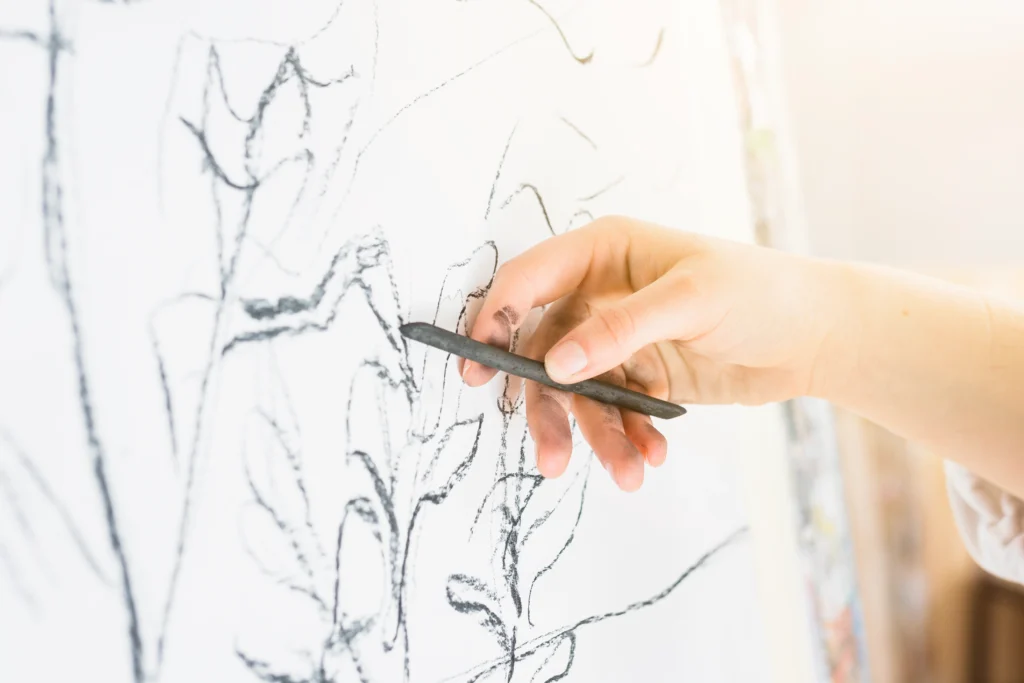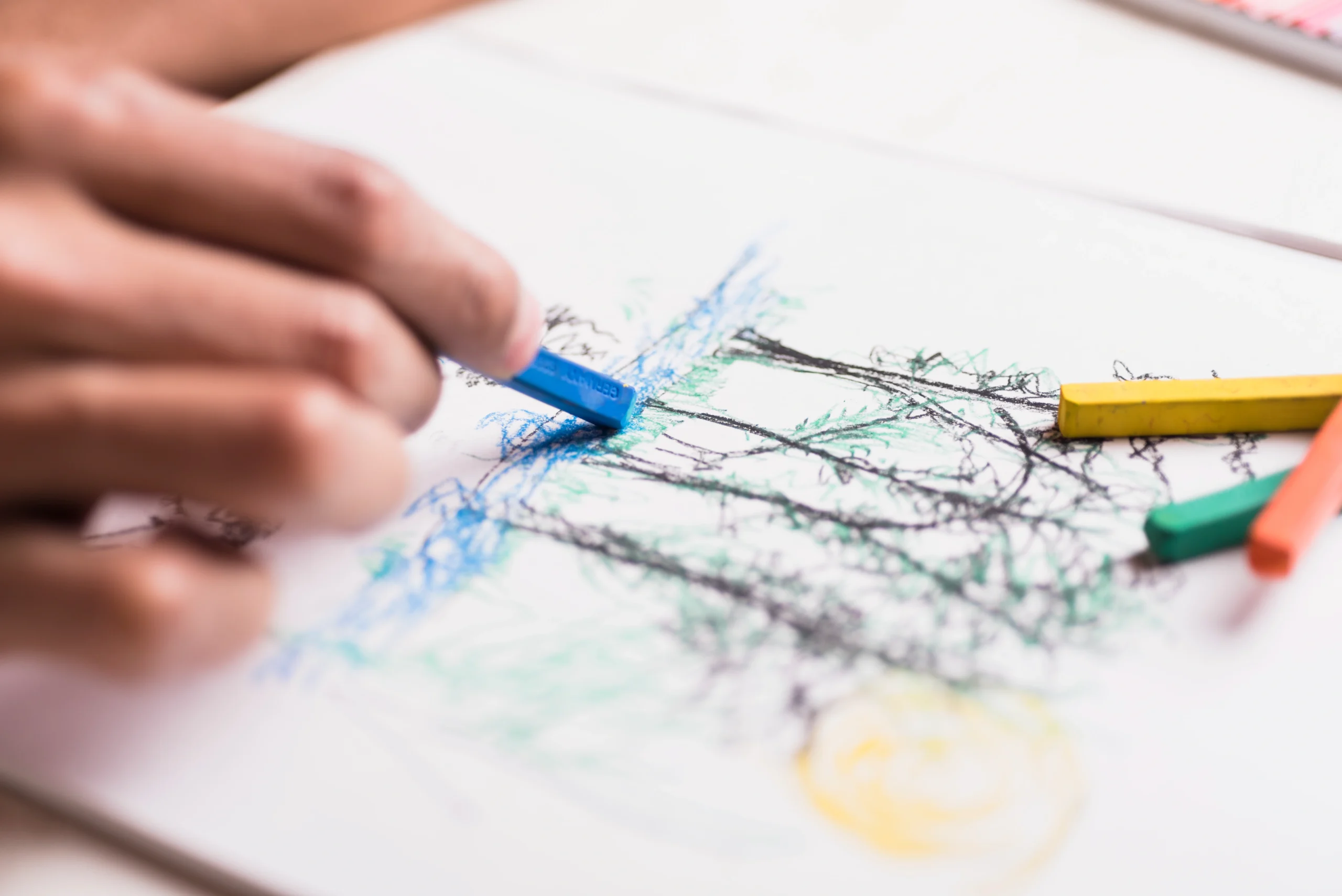Introduction: Abstract Drawing as a Reflection of Our Inner Self
When we think of drawing, we often imagine representations of the outer world – landscapes, portraits, or everyday objects. However, drawing can also be a powerful tool for exploring and expressing something deeper: the inner bodily language. Abstract drawing – spontaneous, without rules – can serve as a mirror of our internal states, revealing subtle physical tensions, heart rhythms, or the flow of thoughts that are often difficult to express in words.
In this article, we will explore how the simple act of drawing – especially observational drawing, where we focus on the smallest details or everyday objects seen from unusual angles – can reprogram the way we perceive the world around us. The goal isn’t to “see better,” but to unlearn the superficial, conditioned gaze that society imposes, allowing us to see the world with more clarity and depth.
The Body’s Language and Micro-Sensations
Before we start drawing, it’s important to understand what micro-sensations are and how they relate to our bodily language. Micro-sensations are those small, often imperceptible physical and mental responses that our body gives, such as muscle tension, the acceleration of our heartbeat, or a feeling of lightness or heaviness. These sensations are so subtle that we often don’t consciously identify them, but they have a real impact on how we feel and react to our surroundings.
Our body, often, communicates more than our conscious mind perceives. For example, you might not be actively thinking about a problem, but you may feel tension in your jaw or a knot in your stomach. Drawing helps us access these internal states in a non-verbal way, capturing these small movements and tensions in lines, forms, and gestures.
Drawing the Inner Body: How Abstract Drawing Reflects Physical and Mental States
Abstract drawing doesn’t require a faithful representation of objects or figures; rather, it focuses on movement, form, and energy. When we use drawing as a tool to explore our internal bodily language, we can focus on the physical sensations of the stroke: the pressure of the pencil, the speed of the line, and the rhythm of the movement. These small decisions can become a map of our inner world.
Pencil Pressure: Connecting with Body Tension
The pressure we apply to the pencil when drawing can tell us a lot about how we feel physically. If we’re tense, our hand might apply excessive pressure, creating dark and bold lines. If we’re relaxed, the stroke might be softer and more fluid. As we draw, we begin to notice how these pressures are related to the tensions and relaxations we feel in our bodies.
Line Speed: Synchronizing with the Body’s Rhythm
The speed at which we draw is also a reflection of our inner state. If we’re anxious or agitated, our hands might move quickly, with short and rapid strokes, representing a fast-paced flow of thoughts or a feeling of urgency. On the other hand, if we’re calm and in tune with our body, the line can be slower and more continuous, conveying a sense of fluidity and harmony.
Organic Forms: Drawing the Body’s Energy
The forms we choose to create when drawing can also reflect internal energy. Straight lines and sharp angles might suggest rigidity or resistance, while rounded and curved shapes could represent flexibility or relaxation. Abstract drawing allows you to create shapes that don’t follow a specific pattern, but emerge directly from how you feel in the moment.
Practical Exercises to Connect Drawing to the Body
Now that we understand how drawing can reflect our internal bodily language, let’s explore some practical exercises that can help further connect drawing with our physical and mental states. These exercises are designed to help you disconnect from logical thought and tune into the physical sensation of the stroke, allowing you to express your internal state through the drawing process.
Exercise 1: Blind Drawing
The first exercise is simple but effective: blind drawing. Choose a simple object in front of you, like a cup, a fruit, or even your own hand. Close your eyes and draw the object, paying attention exclusively to the movement of your hand and the sensation of pressure and rhythm from the stroke. Don’t worry about shape or result – just focus on the act of drawing and how your body responds to the movement. This exercise helps free the mind from the limitations of the superficial gaze and connects you with the inner perception of what you are drawing.
Exercise 2: Drawing with the Non-Dominant Hand
Another powerful exercise is drawing with your non-dominant hand. This may feel uncomfortable, but that’s what makes it valuable. Using your non-dominant hand forces you to slow down and pay more attention to the drawing process, instead of worrying about the precision of the stroke. Try drawing a continuous line or an abstract pattern, and observe how the sensation of the line changes. This exercise helps access more spontaneous and intuitive mental states, allowing you to connect with parts of your body and mind that are not usually active.
Exercise 3: Drawing the Flow of Thoughts
This exercise involves drawing the flow of your thoughts in real-time. Take a piece of paper and, without thinking, start drawing with quick and curving strokes. Don’t focus on what you’re doing – just draw what comes to mind. If your thoughts are quick and scattered, your drawing will be more chaotic and fast. If you’re calm, the drawing will be more fluid. This exercise not only helps release thoughts but also reveals how your mind and body are relating in the moment.

How Abstract Drawing Can Reprogram the Perception of Body and Mind
Abstract drawing is not just an art form, but also a tool for understanding the body and mind in deep and revealing ways. It forces us to slow down and pay attention to the micro-sensations of our inner world, helping us release tensions and explore subtle mental and emotional states.
With practice, drawing becomes a way to reprogram the way we perceive our body and emotions. Instead of seeing things automatically or superficially, we begin to connect with the more subtle and complex feelings that shape our inner experience.
Conclusion: Drawing as a Map of the Inner Self
Abstract drawing is a powerful tool for self-exploration. It allows us to see and feel our inner world in a new and meaningful way, helping us better understand our tensions, mental states, and subtle emotions. By integrating drawing into our daily practice, we can learn to connect with our micro-sensations and internal movements, creating a physical and emotional map of who we are.
Now, the question is: how can drawing reflect your inner state? Grab your pencil, explore these practices, and allow yourself to disconnect from the superficial gaze, starting to draw your soul.

